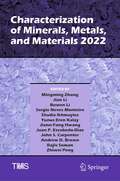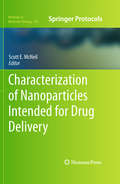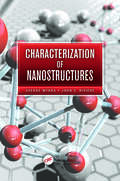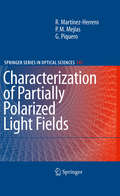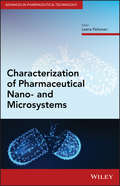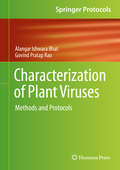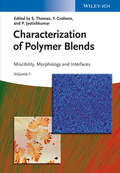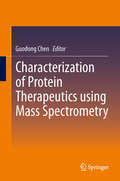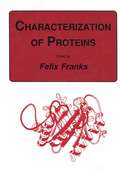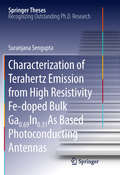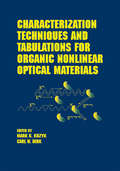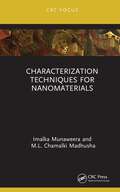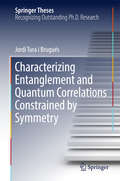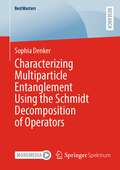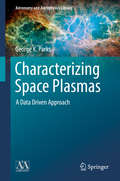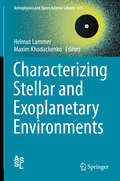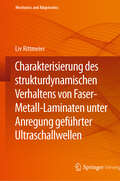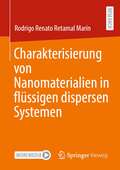- Table View
- List View
Characterization of Minerals, Metals, and Materials 2022 (The Minerals, Metals & Materials Series)
by Jian Li Jiann-Yang Hwang Shadia Ikhmayies John S. Carpenter Sergio Neves Monteiro Mingming Zhang Bowen Li Zhiwei Peng Juan P. Escobedo-Diaz Yunus Eren Kalay Rajiv Soman Andrew D. BrownThe collection focuses on the advancements of characterization of minerals, metals, and materials and the applications of characterization results on the processing of these materials. Advanced characterization methods, techniques, and new instruments are emphasized. Areas of interest include, but are not limited to: • Novel methods and techniques for characterizing materials across a spectrum of systems and processes. • Characterization of mechanical, thermal, electrical, optical, dielectric, magnetic, physical, and other properties of materials. • Characterization of structural, morphological, and topographical natures of materials at micro- and nano- scales. • Characterization of extraction and processing including process development and analysis. • Advances in instrument developments for microstructure analysis and performance evaluation of materials, such as computer tomography (CT), X-ray and neutron diffraction, electron microscopy (SEM, FIB, TEM), and spectroscopy (EDS, WDS, EBSD) techniques. • 2D and 3D modelling for materials characterization.
Characterization of Nanomaterials in Liquid Disperse Systems (Particle Technology Series #28)
by R. R. Retamal MarínThis book describes different aspects of characterization and detection of nanomaterials in liquid disperse systems, such as suspensions, emulsions and suspoemulsions. Natural and technical particulate nanomaterials (NMs) are often present in formulations and products consisting of several disperse phases and complex dispersion media. Specific interfacial properties of the particles, their interactions with each other and with the dispersion medium, have to be considered. For example, the interfacial properties determine whether the particles tend to be arranged in aqueous or lipid phases or at their phase boundaries. The interfacial properties are significantly influenced by the adsorption of dissolved species, i.e., they depend on the composition of the dispersion medium. This poses great challenges for the characterization of these nanoparticle systems and requires adequate preparation methods. The nanoparticle measurement techniques aim at a deep physico-chemical understanding of the dispersity state of nanoparticle systems. Since the dispersity state of nanoparticle systems in an application usually does not correspond to their original manufacturing process, the formulation of new or improved product properties is of decisive importance. The characterization of nanoparticles in complex formulations or matrices requires an adequate sample preparation based on an existing or yet to be developed Standard Operating Procedure (SOP). The structure of the SOPs includes the dispersion regulations, which are of essential importance for comparing reproducible results of nanoparticle measurement with respect to comparability and transferability worldwide. The aim is to separate and isolate relevant NMs with knowledge of the interrelationships.
Characterization of Nanoparticles Intended for Drug Delivery (Methods in Molecular Biology #2789)
by Jeffrey D. Clogston Rachael M. Crist Marina A. Dobrovolskaia Stephan T. SternThis third edition volume expands on the previous editions with new and updated discussions on the latest developments in endotoxin contamination, complex physicochemical properties, in vitro immunotoxicity traits, and in vitro drug release properties. Eight chapters in this book are dedicated to physicochemical characterization techniques and cover newer methods such as asymmetric-flow field-flow fractionation, single particle inductively coupled plasma mass spectrometry, and resistive pulse sensing. The next eighteen chapters explore the immunotoxicity of nanomaterials, including microbial contaminants such as endotoxin and beta-glucans, anti-PEG antibodies, autoimmunity, and immunosuppressive properties. The last two chapters talk about new pharmacology protocols, including a new technique to assess drug release and a tissue distribution assay using PEG immunohistochemistry. Written in the highly successful Methods in Molecular Biology series format, chapters include introductions to their respective topics, lists of the necessary materials and reagents, step-by-step instructions to reproducible laboratory protocols, and tips on troubleshooting and avoiding known pitfalls.Cutting-edge and thorough, Characterization of Nanoparticles Intended for Drug Delivery, Third Edition is a valuable resource that will help both expert and novice researchers further enhance their understanding of this important and developing field.
Characterization of Nanoparticles Intended for Drug Delivery (Methods in Molecular Biology #697)
by Scott E. McneilIn recent years, there have been many exciting breakthroughs in the application of nanotechnology to medicine. In Characterization of Nanoparticles Intended for Drug Delivery, expert researchers explore the latest advances in the field, providing a set of basic methods for the characterization of nanomaterials for medical use. Chapters provide methods to characterize the physiochemical properties (size, aggregation, and surface chemistry) and in vitro immunological and biological characteristics of nanomaterials. Composed in the highly successful Methods in Molecular BiologyTM series format, each chapter contains a brief introduction, step-by-step methods, a list of necessary materials, and a Notes section which shares tips on troubleshooting and avoiding known pitfalls. Comprehensive and informative, Characterization of Nanoparticles Intended for Drug Delivery is an essential survey of methods that are crucial to the preclinical characterization of nanomedicines.
Characterization of Nanostructures
by Sverre Myhra John C. RivièreThe techniques and methods that can be applied to materials characterization on the microscale are numerous and well-established. Divided into two parts, Characterization of Nanostructures provides thumbnail sketches of the most widely used techniques and methods that apply to nanostructures, and discusses typical applications to single nanoscale o
Characterization of Partially Polarized Light Fields (Springer Series in Optical Sciences #147)
by Gemma Piquero Pedro M. Mejías Rosario Martínez-HerreroPolarization involves the vectorial nature of light fields. In current applications of optical science, the electromagnetic description of light with its vector features has been shown to be essential: In practice, optical radiation also exhibits randomness and spatial non-uniformity of the polarization state. Moreover, propagation through photonic devices can alter the correlation properties of the light field, resulting in changes in polarization. All these vectorial properties have been gaining importance in recent years, and they are attracting increasing attention in the literature. This is the framework and the scope of the present book, which includes the authors' own contributions to these issues.
Characterization of Pharmaceutical Nano- and Microsystems (Advances in Pharmaceutical Technology)
by Dennis Douroumis Alfred Fahr Jürgen Siepmann Martin J. Snowden Vladimir TorchilinLearn about the analytical tools used to characterize particulate drug delivery systems with this comprehensive overview Edited by a leading expert in the field, Characterization of Pharmaceutical Nano- and Microsystems provides a complete description of the analytical techniques used to characterize particulate drug systems on the micro- and nanoscale. The book offers readers a full understanding of the basic physicochemical characteristics, material properties and differences between micro- and nanosystems. It explains how and why greater experience and more reliable measurement techniques are required as particle size shrinks, and the measured phenomena grow weaker. Characterization of Pharmaceutical Nano- and Microsystems deals with a wide variety of topics relevant to chemical and solid-state analysis of drug delivery systems, including drug release, permeation, cell interaction, and safety. It is a complete resource for those interested in the development and manufacture of new medicines, the drug development process, and the translation of those drugs into life-enriching and lifesaving medicines. Characterization of Pharmaceutical Nano- and Microsystems covers all of the following topics: An introduction to the analytical tools applied to determine particle size, morphology, and shape Common chemical approaches to drug system characterization A description of solid-state characterization of drug systems Drug release and permeation studies Toxicity and safety issues The interaction of drug particles with cells Perfect for pharmaceutical chemists and engineers, as well as all other industry professionals and researchers who deal with drug delivery systems on a regular basis, Characterization of Pharmaceutical Nano- and Microsystems also belongs on bookshelves of interested students and faculty who interact with this topic.
Characterization of Plant Viruses: Methods and Protocols (Springer Protocols Handbooks)
by Govind Pratap Rao Alangar Ishwara BhatThis book provides detailed information on methodologies used in biological, serological and nucleic acid based assays for the detection, diagnosis and management of plant viruses. The content is divided into six main parts, the first of which presents techniques used in the biological characterization and transmission of viruses, while Part II covers purification and techniques concerning the physico-chemical properties of viruses. In turn, Part III focuses on in vitro expression, production of polyclonal and monoclonal antibodies; and on various serological assays including precipitin tests, ELISA, blot immunoassays, immunosorbent electron microscopy and lateral flow immunoassays. Part IV addresses the isolation of DNA and RNA from plants and nucleic acid based assays such as dot-blot, polymerase chain reaction, real-time PCR, loop-mediated isothermal amplification, rolling circle amplification, recombinase polymerase amplification, and next-generation sequencing approaches. Part V discusses cloning, sequencing, sequence analysis and the production of infectious clones, while the last part (Part VI) provides biotechnological approaches for the management of viruses. Given its scope, the book will be a valuable resource for every laboratory, student and teacher, and for everyone interested in plant virology, plant pathology, plant biology and molecular biology, offering them a practical manual on various aspects of plant viruses.
Characterization of Polymer Blends
by Sabu Thomas Yves Grohens P. JyotishkumarFilling the gap for a reference dedicated to the characterization of polymer blends and their micro and nano morphologies, this book provides comprehensive, systematic coverage in a one-stop, two-volume resource for all those working in the field.Leading researchers from industry and academia, as well as from government and private research institutions around the world summarize recent technical advances in chapters devoted to their individual contributions. In so doing, they examine a wide range of modern characterization techniques, from microscopy and spectroscopy to diffraction, thermal analysis, rheology, mechanical measurements and chromatography. These methods are compared with each other to assist in determining the best solution for both fundamental and applied problems, paying attention to the characterization of nanoscale miscibility and interfaces, both in blends involving copolymers and in immiscible blends. The thermodynamics, miscibility, phase separation, morphology and interfaces in polymer blends are also discussed in light of new insights involving the nanoscopic scale. Finally, the authors detail the processing-morphology-property relationships of polymer blends, as well as the influence of processing on the generation of micro and nano morphologies, and the dependence of these morphologies on the properties of blends. Hot topics such as compatibilization through nanoparticles, miscibility of new biopolymers and nanoscale investigations of interfaces in blends are also addressed.With its application-oriented approach, handpicked selection of topics and expert contributors, this is an outstanding survey for anyone involved in the field of polymer blends for advanced technologies.
Characterization of Protein Therapeutics using Mass Spectrometry
by Guodong ChenThis book highlights current approaches and future trends in the use of mass spectrometry to characterize protein therapies. As one of the most frequently utilized analytical techniques in pharmaceutical research and development, mass spectrometry has been widely used in the characterization of protein therapeutics due to its analytical sensitivity, selectivity, and specificity. This book begins with an overview of mass spectrometry techniques as related to the analysis of protein therapeutics, structural identification strategies, quantitative approaches, followed by studies involving characterization of process related protein drug impurities/degradants, metabolites, higher order structures of protein therapeutics. Both general practitioners in pharmaceutical research and specialists in analytical sciences will benefit from this book that details step-by-step approaches and new strategies to solve challenging problems related to protein therapeutics research and development.
Characterization of Proteins (Biological Methods)
by Felix FranksProteins are the servants of life. They occur in all component parts of living organisms and are staggering in their functional variety, despite their chemical similarity. Even the simplest single-cell organism contains a thousand different proteins, fulfilling a wide range of life-supporting roles. Their production is controlled by the cell’s genetic machinery, and a malfunction of even one protein in the cell will give rise to pathological symptoms. Additions to the total number of known proteins are constantly being made on an increasing scale through the discovery of mutant strains or their production by genetic manipulation; this latter technology has become known as protein engineering. The in vivo functioning of proteins depends critically on the chemical structure of individual peptide chains, but also on the detailed folding of the chains themselves and on their assembly into larger supramolecular structures. The molecules and their functional assemblies possess a limited in vitro stability. Special methods are required for their intact isolation from the source material and for their analysis, both qualitatively and quantitatively. Proteins are also increasingly used as “industrial components,” e.g., in biosensors and immobilized enzymes, because of their specificity, selectivity, and sensitivity. This requires novel and refined processing methods by which the protein isolate can be converted into a form in which it can be utilized.
Characterization of Terahertz Emission from High Resistivity Fe-doped Bulk Ga0.69In0.31As Based Photoconducting Antennas (Springer Theses)
by Suranjana SenguptaTerahertz science and technology is attracting great interest due to its application in a wide array of fields made possible by the development of new and improved terahertz radiation sources and detectors. This book focuses on the development and characterization of one such source - namely the semi-large aperture photoconducting (PC) antenna fabricated on Fe-doped bulk Ga0.69In0.31As substrate. The high ultrafast carrier mobility, high resistivity, and subpicosecond carrier lifetime along with low bandgap make Ga0.69In0.31As an excellent candidate for PC antenna based THz emitter that can be photoexcited by compact Yb-based multiwatt laser systems for high power THz emission. The research is aimed at evaluating the impact of physical properties of a semi-large aperture Ga0.69In0.31As PC antenna upon its THz generation efficiency, and is motivated by the ultimate goal of developing a high-power terahertz radiation source for time-domain terahertz spectroscopy and imaging systems.
Characterization of the Electrical Environment
by Ralph L. Woodside Moninuddin Syed Axel J. Ghazi David BodleA communication system must have adequate electrical protection in order to meet the reliability standards for commercially acceptable service and to keep down maintenance expenses. This report characterizes, from the viewpoint of electrical protection and coordination, the conditions of the electrical environment to which communication facilities are exposed. It gives consideration to both present and anticipated future conditions, and covers such topics as the effects of lightning, interference from power networks, electric shock, earth potential gradients, corrosion, over-voltage in AC power utilization circuits,her and electromagnetic pulses.Characterization of the Electrical Environment is a current reference on the design factors required to ensure reliable performance of communication facilities under field operating conditions. It will be useful as a manual for practicing engineers in telecommunications, and as a tutorial textbook in engineering schools in North America, Europe, and elsewhere.
Characterization Techniques and Tabulations for Organic Nonlinear Optical Materials (Optical Science And Engineering Ser. #60)
by Kuzyk""Furnishes table of nonlinear optical properties of organic substances as well as experimental procedures for measuring the nonlinearity of the elements tabulated, including composite materials-offering support for scientists and engineers involved in characterizing, optimizing, and producing materials for manufacturing optical devices.
Characterization Techniques for Nanomaterials
by Imalka Munaweera M.L. Chamalki MadhushaManipulation of matter at the nanoscale level is the key factor in nanotechnology, and it is considered as a great driving force behind the current industrial revolution since it offers facile and feasible remedies for many problems. Because of the unique characteristic properties of nanomaterials, they can be employed in a wide variety of fields such as agriculture and food technology, catalysis, biomedical applications, tissue culture engineering and fertilizers, etc. In this regard, characterization of nanomaterials plays a significant role in determining their optical, thermal, and physicochemical properties. Many techniques have been used in nanomaterial characterization and the most important techniques are discussed in detail in this book with its principles, basic operation procedures and applications with suitable examples. In summary, this book offers a broad content on the most important chemical and structural characterization techniques of nanomaterials. The book offers comprehensive coverage of the most essential topics, including: Provides a comprehensive understanding about physical and chemical characterization techniques of nanomaterials Includes details about basic principles of each characterization technique with appropriate examples Covers most of the important characterization techniques that need to know under the level of undergraduate/early career scientists/beginners in materials chemistry Provides all the basic knowledge to understand and carry out the respective analysis of nanomaterials Fulfills the timely need of a book that covers the most important and useful characterization techniques in nanomaterial characterization Up to date, there are no other books/book chapters which discuss most of these nanocharacterization techniques in one segment with all the basic instrumentation details and narrated examples of nanomaterial characterization. In a nutshell, this book will be a great asset to undergraduates/early career scientists/beginners of material science since it provides a comprehensive and complete understanding about most of the techniques nanocharacterization tools in a short time. Intended audience is based on science education while specifically focusing on undergraduates/graduate students/early scientists and beginners of chemistry, materials chemistry and nanotechnology and nanoscience.
Characterizing Entanglement and Quantum Correlations Constrained by Symmetry (Springer Theses)
by Jordi Tura i BruguésThis thesis focuses on the study and characterization of entanglement and nonlocal correlations constrained under symmetries. It includes original results as well as detailed methods and explanations for a number of different threads of research: positive partial transpose (PPT) entanglement in the symmetric states; a novel, experimentally friendly method to detect nonlocal correlations in many-body systems; the non-equivalence between entanglement and nonlocality; and elemental monogamies of correlations. Entanglement and nonlocal correlations constitute two fundamental resources for quantum information processing, as they allow novel tasks that are otherwise impossible in a classical scenario. However, their elusive characterization is still a central problem in quantum information theory. The main reason why such a fundamental issue remains a formidable challenge lies in the exponential growth in complexity of the Hilbert space as well as the space of multipartite correlations. Physical systems of interest, on the other hand, display symmetries that can be exploited to reduce this complexity, opening the possibility that some of these questions become tractable for such systems.
Characterizing Groundwater Flow Dynamics and Storage Capacity in an Active Rock Glacier (BestMasters)
by Simon KainzAlpine aquifers play a critical role in the hydrology of mountainous areas by sustaining base flow in downstream rivers during dry periods and retarding flood propagation after heavy precipitation events. Progressing climate change alters climatic and meteorological boundary conditions as well as the hydraulic response of alpine catchments by ablating glaciers and thawing permafrost. Rock glaciers exert a controlling influence on the catchment response due to their prominent groundwater storage and complex drainage characteristics. This thesis investigates the hydrogeology and internal structure of the active rock glacier Innere Ölgrube (Ötztal Alps), which governs catchment runoff and is affected by permafrost degradation. A 3D geometrical model of its internal structure is obtained by combining geophysical data and permafrost creep modelling. Available data and new results are integrated into a conceptual hydrogeological model providing a sound basis for the implementation of a prospective numerical groundwater flow model. Hydraulic properties of the hydrostratigraphic units constituting the rock glacier are estimated and groundwater recharge fluxes quantified. Fundamental properties of the heterogeneous groundwater flow system within the rock glacier are discussed and compared to existing rock glacier studies.
Characterizing Multiparticle Entanglement Using the Schmidt Decomposition of Operators (BestMasters)
by Sophia DenkerCharacterizing entanglement is an important issue in quantum information, as it is considered to be a resource for many applications such as quantum key distribution or quantum metrology. One useful tool to detect and quantify entanglement are witness operators. A standard way to construct them is based on the fidelity of pure states and mathematically relies on the Schmidt decomposition of vectors. In this book a method to build entanglement witnesses using the Schmidt decomposition of operators is presented. One can show that these are strictly stronger than the fidelity witnesses. Moreover, the concept can be generalized easily to the multipartite case, and one may use it to quantify the dimensionality of entanglement. Finally, this scheme will be used to provide two algorithms that can be combined to improve given witnesses for multiparticle entanglement.
Characterizing Space Plasmas: A Data Driven Approach (Astronomy and Astrophysics Library)
by George K. ParksThis didactic book uses a data-driven approach to connect measurements made by plasma instruments to the real world. This approach makes full use of the instruments’ capability and examines the data at the most detailed level an experiment can provide. Students using this approach will learn what instruments can measure, and working with real-world data will pave their way to models consistent with these observations. While conceived as a teaching tool, the book contains a considerable amount of new information. It emphasizes recent results, such as particle measurements made from the Cluster ion experiment, explores the consequences of new discoveries, and evaluates new trends or techniques in the field. At the same time, the author ensures that the physical concepts used to interpret the data are general and widely applicable. The topics included help readers understand basic problems fundamental to space plasma physics. Some are appearing for the first time in a space physics textbook. Others present different perspectives and interpretations of old problems and models that were previously considered incontestable. This book is essential reading for graduate students in space plasma physics, and a useful reference for the broader astrophysics community.
Characterizing Stellar and Exoplanetary Environments (Astrophysics and Space Science Library #411)
by Helmut Lammer Maxim KhodachenkoIn this book an international group of specialists discusses studies of exoplanets subjected to extreme stellar radiation and plasma conditions. It is shown that such studies will help us to understand how terrestrial planets and their atmospheres, including the early Venus, Earth and Mars, evolved during the host star's active early phase. The book presents an analysis of findings from Hubble Space Telescope observations of transiting exoplanets, as well as applications of advanced numerical models for characterizing the upper atmosphere structure and stellar environments of exoplanets. The authors also address detections of atoms and molecules in the atmosphere of "hot Jupiters" by NASA's Spitzer telescope. The observational and theoretical investigations and discoveries presented are both timely and important in the context of the next generation of space telescopes. The book is divided into four main parts, grouping chapters on exoplanet host star radiation and plasma environments, exoplanet upper atmosphere and environment observations, exoplanet and stellar magnetospheres, and exoplanet observation and characterization. The book closes with an outlook on the future of this research field.
Characterizing the Robustness of Science: After the Practice Turn in Philosophy of Science (Boston Studies in the Philosophy and History of Science #292)
by William Wimsatt Emiliano Trizio Léna Soler Thomas NicklesMature sciences have been long been characterized in terms of the "successfulness", "reliability" or "trustworthiness" of their theoretical, experimental or technical accomplishments. Today many philosophers of science talk of "robustness", often without specifying in a precise way the meaning of this term. This lack of clarity is the cause of frequent misunderstandings, since all these notions, and that of robustness in particular, are connected to fundamental issues, which concern nothing less than the very nature of science and its specificity with respect to other human practices, the nature of rationality and of scientific progress; and science's claim to be a truth-conducive activity. This book offers for the first time a comprehensive analysis of the problem of robustness, and in general, that of the reliability of science, based on several detailed case studies and on philosophical essays inspired by the so-called practical turn in philosophy of science.
Characterizing the U.S. Industrial Base for Coal-Powered Electricity
by Constantine Samaras Jeffrey A. Drezner Henry H. Willis Evan BloomTo determine whether the industrial base for the U. S. domestic coal-based electricity generation industry can maintain the capability to design, construct, operate, and maintain coal-fired electricity generating units within reasonable cost, schedule, performance, environmental, and quality expectations, this book reviewsinterviews with stakeholders and data describing key elements of industry capability and validation or verification of concerns.
Charakterisierung des strukturdynamischen Verhaltens von Faser-Metall-Laminaten unter Anregung geführter Ultraschallwellen (Mechanics and Adaptronics)
by Liv RittmeierDas Ziel dieses Buches ist die Charakterisierung und Beschreibung des Ausbreitungsverhaltens geführter Ultraschallwellen (GUW) in Faserverbund-Metall-Laminaten (FML). Sie gliedert sich in drei experimentelle Untersuchungen. Im ersten Experiment wird das Phasenverhältnis der Schwingungen an Strukturober – und -unterseite als Maß für die Ähnlichkeit zu den für isotrope Materialien hergeleiteten Lamb-Wellen untersucht. Dazu erfolgt die Entwicklung eines Verfahrens zum Phasenwinkelvergleich, welches auf der Continuous Wavelet Transformation sowie der Short-Time Fourier-Transformation beruht. Damit kann anhand simulierter Zeitsignalverläufe in verschiedenen Strukturen gezeigt werden, dass sich auch in FML die geführten Wellen wie klassische Lamb-Wellen ausbilden. Auch in einer experimentellen Untersuchung an einem FML kann die Beobachtungen für gleichphasige Schwingungen bestätigt und für Schwingungen mit Phasenversatz geschlussfolgert werden. Im anschließenden Experiment wird die Frage adressiert, wie sich das Wellenausbreitungsverhalten im Inneren von FML verhält. Dazu werden auf piezoelektrischem Polyvinylidenfluorid (PVDF)-basierende Foliensensoren gewählt, die sich aufgrund ihrer geringen Abmaße und ihrer geringen akustischen Impedanz gut für die möglichst rückwirkungsarme Integration in flache Strukturen aus Faserverbundkunststoff (FVK) eignen. Die erwartete Wirkweise der PVDF-Foliensensoren unter GUW-Erfassung wird erklärt. Anschließend erfolgt die experimentelle Untersuchung des FML, in deren Rahmen die Wellenmoden identifiziert werden sowie eine Abschätzung des Verschiebungsfeldverlaufes entlang der Strukturhöhe gegeben wird. Die Ergebnisse liefern einen experimentellen Hinweis auf die Modenkopplung im gewählten Laminataufbau. Das dritte und letzte Experiment liefert den konkreten Anwendungsfall der Schadensdetektion und -charakterisierung in FML. Dazu werden im Rahmen einer Parameterstudie ein Referenzlaminat sowie zwei Laminate mit künstlichen Delaminationen bei ansonsten übereinstimmendem Laminataufbau gefertigt. Ziel ist zum einen die Untersuchung, inwiefern sich eine unterschiedliche relative Höhenlage eines Schadens im Wellenfeld der FML zeigt. Zum anderen soll geprüft werden, inwiefern sich Schadensinformationen über einen integrierten Sensor erfassen lassen. Flächige Vergleichsmessungen an den Plattenoberflächen über ein Laser-Doppler-Vibrometer dienen der Abschätzung der über die integrierten PVDF-Foliensensoren und unterstützen die Auswertung. Es kann gezeigt werden, dass anhand des horizontalen Scherwellenmoden zusätzliche Schadensinformation über den integrierten Sensor gewonnen werden kann. Über Wellenausbreitungsszenarien gelingt es das Auftreten einiger Wellenpakete in den Sensorzeitsignalen über Modenkonversion zu erklären. Es erfolgt eine Zusammenfassung der Ergebnisse sowie ein Ausblick auf mögliche Folgearbeiten zu jedem Experiment.
Charakterisierung von Nanomaterialien in flüssigen dispersen Systemen
by Rodrigo Renato Retamal MarínHäufig liegen natürliche und technische partikuläre Nanomaterialien (NM) in Formulierungen (i.d.R. Suspensionen, Emulsionen oder Suspoemulsionen) und Produkten vor, welche aus mehreren dispersen Phasen und komplexen Dispersionsmedien bestehen. Dabei gilt es, spezifische Grenzflächeneigenschaften der Partikel, ihre Wechselwirkungen untereinander und mit dem Dispersionsmedium zu berücksichtigen. Beispielsweise bestimmen die Grenzflächeneigenschaften, ob sich die Partikel eher in wässriger Phase oder in Lipidphase bzw. an deren Phasengrenzen anordnen. Die Grenzflächeneigenschaften werden maßgeblich durch die Adsorption gelöster Spezies beeinflusst, hängen also von der Zusammensetzung des Dispersionsmediums ab. In dieser Arbeit werden mit theoretischer und empirischer Forschung wie methodischer Vorgehensweise neue Beiträge zur Nanopartikelcharakterisierung erarbeitet. Die notwendige Ausarbeitung von Richtlinien an SOPs für die Charakterisierung von Nanopartikelsystemen wird hierbei berücksichtigt. Diese Richtlinien ermöglichen eine Anwendung im Kontext verschiedenartiger Analyseaufgaben, und die Ergebnisse können dem Leser dieser Arbeit unmittelbar Nutzen bringen.
Charakterisierung von Wartezeiten in verschiedenen Modellen von Quantennetzwerken (BestMasters)
by Lisa Teresa WeinbrennerQuantennetzwerke ermöglichen ähnlich wie klassische Kommunikationsnetzwerke, wie zum Beispiel das Internet, eine Verbindung zwischen potentiell weit entfernten Nutzern. Zu diesem Zweck werden verschränkte Quantenzustände über die einzelnen Verbindungen verteilt und können beispielsweise zur beweisbar sicheren Kommunikation mittels Quantenkryptographie genutzt werden. Quantennetzwerke bestehen aus vielen verschiedenen probabilistischen Bausteinen: Sowohl die Erzeugung verschränkter Zustände als auch deren Übertragung zwischen unterschiedlichen Netzwerkknoten und die Verbindung benachbarter Links entsprechen unterschiedlichen stochastischen Prozessen. In dem vorliegenden Buch werden verschiedene Modellierungsmöglichkeiten dieser Prozesse vorgestellt und verglichen. Das Ziel ist dabei jeweils die Berechnung der Wartezeit bis zur Erzeugung einer Ende-zu-Ende-Verbindung zwischen den Kommunikationspartnern.
